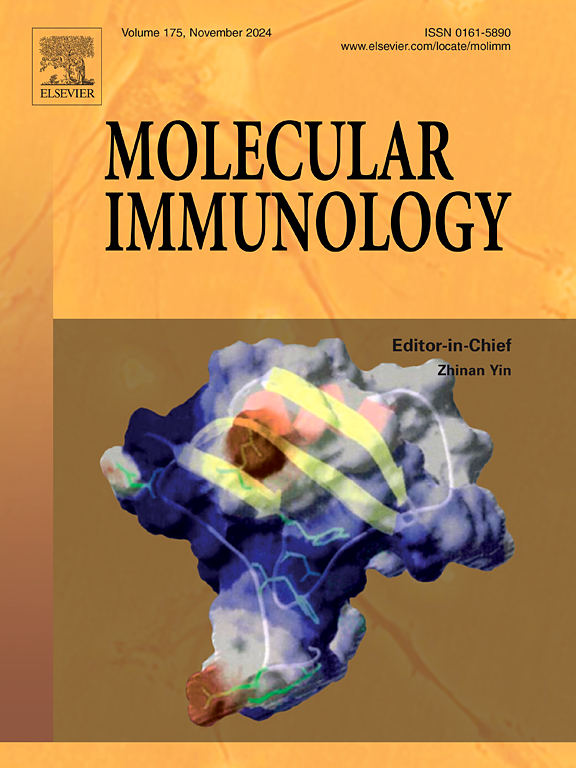Paeoniflorin as a potential agent for urticaria treatment: Suppressing mast cell degranulation through HMGB1/TLR4/NF-κB signaling inhibition
IF 3.2
3区 医学
Q2 BIOCHEMISTRY & MOLECULAR BIOLOGY
引用次数: 0
Abstract
Introduction
Paeoniflorin (PF) has strong immunomodulatory effects and has been widely used in the treatment of many diseases, but its mechanism of action in urticaria is not clear. The aim of this experiment was to investigate the role and mechanism of paeoniflorin in improving mast cell degranulation in urticaria.
Methods
The mouse model of urticaria was replicated by ovalbumin+ aluminum hydroxide method, and the mast cell degranulation model was induced by anti-DNP IgE+ Dinitrophenyl- Bovine Serum Albumin (DNP-BSA), and the mice and cells were intervened by different doses of PF. The histopathological changes of the dorsal skin were observed using hematoxylin-eosin (HE) staining, the infiltration of mast cells was observed by Toluidine blue staining, the expression of mast cell tryptase (MCT) was examined by Immunohistochemical staining, the cell viability was detected by CCK8 assay, and Rhod-2/AM flow cytometry assay to determine calcium ion content, enzyme-linked immunosorbent assay (ELISA) detected mast cell degranulation-associated factors, and Western blot analyzed HMGB1/TLR4/NF-κB signaling factors.
Results
PF reduced the number of scratches in mice, ameliorated histopathological damage in dorsal skin, decreased mast cell degranulation rate, reduced the levels of Ca2 +, MCT, β-HEX, HIS, MCP-1, TNF-α, and IL-13, and inhibited the expression of HMGB1, TLR4, MyD88, NF-κB p65 (Nucleus), and p-IκBα. Moreover, Rec-HMGB1 reversed the effect of PF.
Conclusion
PF mitigates urticarial mast cell degranulation through the inhibition of the HMGB1/TLR4/NF-κB signaling pathway, suggesting its potential as a therapeutic agent for the treatment of urticaria.
芍药苷作为治疗荨麻疹的潜在药物:通过抑制HMGB1/TLR4/NF-κB信号传导抑制肥大细胞脱颗粒
芍药苷(paeoniflorin, PF)具有较强的免疫调节作用,已广泛应用于多种疾病的治疗,但其在荨麻疹中的作用机制尚不清楚。本实验旨在探讨芍药苷促进荨麻疹肥大细胞脱颗粒的作用及其机制。方法采用卵清蛋白+ 氢氧化铝法复制小鼠荨麻疹模型,采用抗dnp IgE+ 二硝基苯-牛血清白蛋白(DNP-BSA)诱导肥大细胞脱颗粒模型,并用不同剂量的PF干预小鼠和细胞,苏木精-伊红(HE)染色观察背侧皮肤的组织病理变化,甲苯胺蓝染色观察肥大细胞的浸润情况。免疫组化染色检测肥大细胞胰蛋白酶(MCT)表达,CCK8法检测细胞活力,Rhod-2/AM流式细胞术检测钙离子含量,酶联免疫吸附法(ELISA)检测肥大细胞脱颗粒相关因子,Western blot检测HMGB1/TLR4/NF-κB信号因子。结果spf可减少小鼠划伤次数,改善背侧皮肤组织病理损伤,降低肥大细胞脱颗粒率,降低Ca2 +、MCT、β-HEX、HIS、MCP-1、TNF-α、IL-13水平,抑制HMGB1、TLR4、MyD88、NF-κB p65 (Nucleus)、p -κB α的表达。结论pf通过抑制HMGB1/TLR4/NF-κB信号通路减轻荨麻疹肥大细胞脱颗粒,提示其作为治疗荨麻疹的药物潜力。
本文章由计算机程序翻译,如有差异,请以英文原文为准。
求助全文
约1分钟内获得全文
求助全文
来源期刊

Molecular immunology
医学-免疫学
CiteScore
6.90
自引率
2.80%
发文量
324
审稿时长
50 days
期刊介绍:
Molecular Immunology publishes original articles, reviews and commentaries on all areas of immunology, with a particular focus on description of cellular, biochemical or genetic mechanisms underlying immunological phenomena. Studies on all model organisms, from invertebrates to humans, are suitable. Examples include, but are not restricted to:
Infection, autoimmunity, transplantation, immunodeficiencies, inflammation and tumor immunology
Mechanisms of induction, regulation and termination of innate and adaptive immunity
Intercellular communication, cooperation and regulation
Intracellular mechanisms of immunity (endocytosis, protein trafficking, pathogen recognition, antigen presentation, etc)
Mechanisms of action of the cells and molecules of the immune system
Structural analysis
Development of the immune system
Comparative immunology and evolution of the immune system
"Omics" studies and bioinformatics
Vaccines, biotechnology and therapeutic manipulation of the immune system (therapeutic antibodies, cytokines, cellular therapies, etc)
Technical developments.
 求助内容:
求助内容: 应助结果提醒方式:
应助结果提醒方式:


